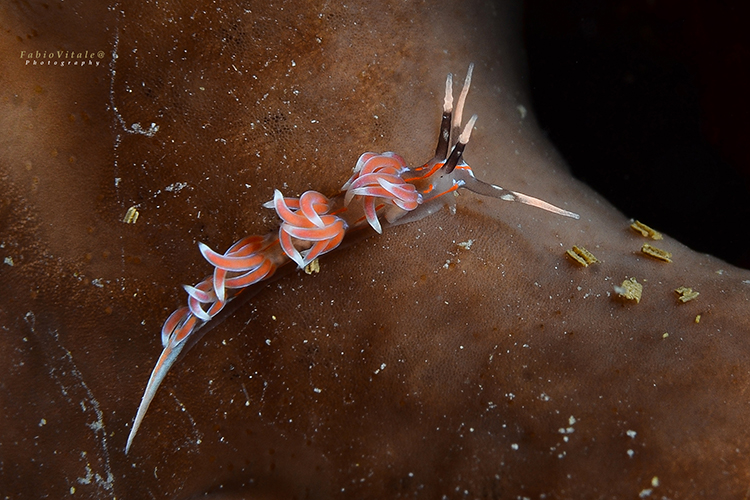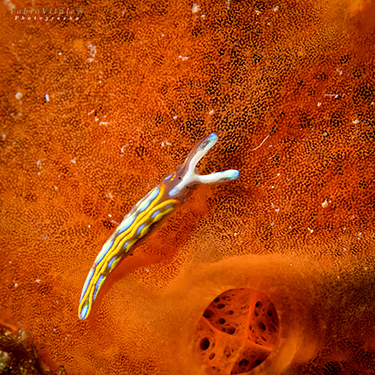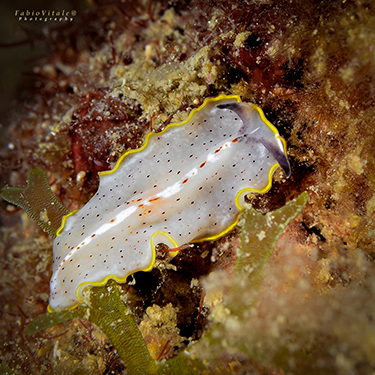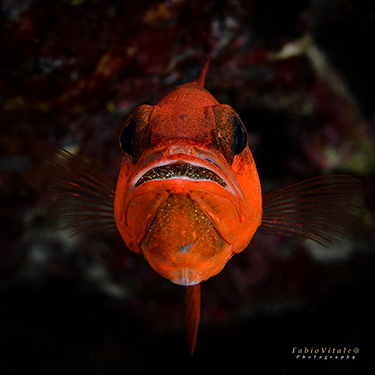Fotografia Subacquea Underwater photography
La fotografia subacquea è un argomento trattato in lungo e largo, le attrezzature da utilizzare sono molto note e tanto pubblicizzate da case costruttrici e commercianti. Quindi, parlare di Fotografia subacquea sembrerebbe un tema ormai poco interessante.
Forse meno noioso potrebbe essere un argomento che interagisca con le capacità tecniche e creative del Fotografo subacqueo che si appresta a fare un’immersione e che magari si è posto “ come sarebbe sempre giusto fare prima del tuffo ” uno o più obiettivi da raggiungere in quella giornata.
Ipotizziamo di aver scelto di fare della Macro Fotografia subacquea.
Questo sarebbe il momento di porsi almeno un paio di domande:
A - Come scegliamo i nostri soggetti?
B - Dove cerchiamo i nostri soggetti?
Alla prima domanda possiamo darci un po’ risposte piuttosto ovvie:
A1 - I soggetti non dovranno essere molto grandi, poi dipenderà anche dalla nostra creatività, se vogliamo ottenere una foto macro molto dettagliata dell’intero soggetto questo dovrà essere necessariamente molto piccolo circa 3 cm, se invece il nostro desiderio sarà di riprodurre i dettagli di una parte di questo soggetto allora potremo anche guardare a soggetti un po’ più grandi.
A2 - Necessariamente il nostro soggetto dovrà essere poco mobile o meglio se fermo. Quindi dovrà essere un soggetto che sarà ancorato al fondo o che vive a contatto col fondo. Non escludiamo ovviamente la possibilità di trovare soggetti anche pelagici, ma sono casi davvero meno frequenti.
A3 - Ci capiterà di trovare soggetti interessanti ma che al momento del primo avvistamento non sono in una situazione favorevole alla foto. Come naturalmente saprete il soggetto, nella nostra foto, avrà sempre uno sfondo in cui verrà fotografato e nonostante le nostre capacità tecniche i nostri scatti saranno più interessanti se questo soggetto al momento dello scatto si trovi in un contesto che esalti la sua forma, i suoi colori, i suoi movimenti ed anche uno sfondo favorevole. Generalmente basterà avere pazienza ed aspettare che l’organismo che abbiamo deciso di fotografare raggiunga le condizioni migliori. Non è mai favorevole toccare l’organismo che vogliamo fotografare per molti motivi, primo tra tutti che potremmo danneggiare anche gravemente l’organismo stesso, poi che lo stesso infastidito dalla nostra presenza non avrà più quel comportamento naturale nel suo ambiente di riferimento che è basilare da riprodurre nelle nostre foto.
Nel nostro Mar Mediterraneo i soggetti di piccole dimensioni che giustifichino il nostro desiderio/obiettivo di realizzare della Macro Fotografia sono molti, perché gli organismi mediterranei non sono di grandi dimensioni.
Iniziamo a fare un piccolo elenco dei potenziali gruppi che porremo cercare di incontrare nella nostra immersione e che magari siano anche belli ed interessanti da fotografare.
In un primo elenco includerei ai primi posti: Nudibranchi o meglio gli Eterobranchi Marini, Platelminti e Pesci.
Underwater photography is a topic covered far and wide, the equipment to be used is well known and much advertised by manufacturers and traders. Therefore, talking about underwater photography would seem to be an uninteresting topic by now.
Perhaps less boring could be a topic that interacts with the technical and creative skills of the Underwater Photographer who is preparing to dive and who perhaps has set for himself "as it would always be right to do before the dive" one or more objectives to be achieved in that day.
Let's assume that you have chosen to do underwater Macro Photography.
This would be the time to ask yourself at least a couple of questions:
A - How do we choose our subjects?
B - Where do we look for our subjects?
We can give ourselves some rather obvious answers to the first question.
A1 - The subjects must not be very large, then it will also depend on our creativity, if we want to obtain a very detailed macro photo of the entire subject this must necessarily be very small about 3 cm, if instead our desire is to reproduce the details of part of this subject then we can also look at slightly larger subjects.
A2 - Necessarily our subject will have to be not very mobile or better still. So it will have to be a subject who will be anchored to the bottom or who lives in contact with the bottom. Obviously we do not exclude the possibility of finding pelagic subjects too, but these are really less frequent cases.
A3 - We will happen to find interesting subjects but at the time of the first sighting they are not in a favorable situation for the photo. As you naturally know, the subject in our photo will always have a background in which it will be photographed and despite our technical skills, our shots will be more interesting if this subject, at the time of shooting, is in a context that enhances its shape, its colors, its movements and also a favorable background. Generally it will be enough to be patient and wait for the organism that we have decided to photograph to reach the best conditions. It is never favorable to touch the organism we want to photograph for many reasons, first of all that we could even seriously damage the organism itself, then that the same, annoyed by our presence, will no longer have that natural behavior in its reference environment which is fundamental to be reproduced in our photos.
In our Mediterranean Sea there are many small subjects that justify our desire/objective to create Macro Photography, because Mediterranean organisms are not large.
Let's begin by making a small list of potential groups that we will try to meet during our dive and which may also be beautiful and interesting to photograph. In a first list I would include in the first places: Nudibranchs or rather the Marine Heterobranchs, Platyhelminths and Fishes.




Prima di iniziare a darci delle risposte al punto B) riteniamo necessario affrontare qualche
raccomandazione / suggerimento di carattere generale:
Illuminazione
Abbiamo messo questo “suggerimento” al primo posto perché l’intensità delle nostre lampade - in continua crescita - infastidisce non poco i nostri soggetti. Come vedremo la gran parte di questi soggetti non hanno dei veri occhi (tranne i pesci) ma hanno bulbi oculari spesso connessi al sistema nervoso che li rende fortemente sensibili alla luce. Spesso per questi organismi l’intensità della luce è una guida, pertanto usiamo con “parsimonia” le nostre lampade e se possiamo filtriamo il fascio luminoso con colorazioni che attenuino l’intensità. Questo ci aiuterà molto ad avere il soggetto più disponibile ai nostri scatti.
Aree preferenziali di ricerca
Come vedremo più avanti sarà quasi una costante suggerirvi di ricercare i nostri soggetti in aree in ombra. In ombra sarà un tunnel, una piccola grotta, una semplice cavità,uno sgrottamento, una parete. Queste condizioni, se poi le potessimo trovare anche in aree meno esposte a mareggiate o ad una biocenosi intensa certamente offrirebbero maggiori probabilità di poter osservare soggetti per le nostre Macro Fotografie.
Gestione dell’immersione
Questo suggerimento sembrerà banale, ma vi assicuriamo che forse è il più importante da “rispettare”, ci riferiamo alla velocità di osservazione che porremo durante l’immersione. Sarà fondamentale procedere molto molto lentamente, perché i nostri “modelli” spessissimo possono essere nascosti o posizionati in modo non sempre visibile a prima vista. Talvolta sono posizionati mimeticamente su altri organismi che richiedono un po’ di adattamento della nostra capacità di osservazione. Naturalmente non dobbiamo mai avere problemi di “vista” nel senso che dobbiamo poter distinguere nitidamente oggetti anche di pochissimi millimetri, tutto questo ci permetterà di osservare una natura straordinariamente bella e diversificata. Magari quando decideremo di fare uno spostamento più ampio facciamolo rapidamente e poi torneremo a procedere con i soliti movimenti davvero lenti.
Before starting to give us answers to point B) we believe it is necessary to address some recommendations / suggestions of a general nature:
Lighting
We put this "suggestion" first because the intensity of our lamps - constantly growing - annoys our subjects quite a bit. As we shall see, most of these subjects do not have real eyes (except fish) but have eyeballs often connected to the nervous system which makes them highly sensitive to light. Often for these organisms the intensity of the light is a guide, therefore we use our lamps "sparingly" and if we can we filter the light beam with colors that attenuate the intensity. This will help us a lot to have the subject more available to our shots.
Preferred areas of research
As we will see later it will be almost a constant to suggest that you look for our subjects in shaded areas. In the shade it will be a tunnel, a small cave, a simple cavity, a cave-in, a wall. These conditions, if we could find them also in areas less exposed to storm surges or to an intense biocenosis, would certainly offer more chances of being able to observe subjects for our Macro Photographs.
Dive management
This suggestion may seem trivial, but we assure you that it is perhaps the most important to "respect", we refer to the observation speed that we will set during the dive. It will be essential to proceed very very slowly, because our "models" can very often be hidden or positioned in a way that is not always visible at first sight. Sometimes they are positioned mimetically on other organisms that require some adaptation of our observation skills. Of course we must never have "sight" problems in the sense that we must be able to clearly distinguish objects even of very few millimeters, all this will allow us to observe an extraordinarily beautiful and diversified nature. Maybe when we decide to make a larger shift let's do it quickly and then we'll go back to proceeding with the usual really slow movements.
